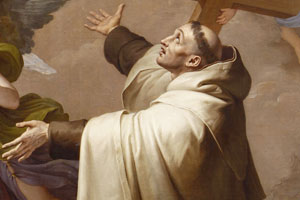Church of San Niccolò al Carmine
From the Striped to the White Mantle
The striped mantle was a sort of woollen cloak, entirely woven – and not sewn - with seven horizontal black and white stripes. The stripes probably recalled the virtues: the four cardinal ones (Fortitude, Temperance, Justice, Prudence) are represented by the white stripes, and the three theological ones (Hope, Faith and Charity) by the black ones. According to another possible interpretation, white was the symbol of a pure heart and the number four was reminiscent of the number of the Gospels; the white stripes were interspersed by three black stripes, recalling the acts of repentance (contrition, confession, celibacy) required for the friar’s salvation.
Because of the prejudice that surrounded the hood - according to medieval symbolism black and white striped robes were worn by the outcasts and by the “outsiders” - the Pope offered the Carmelites the possibility to change their habit and from 1287 they began to wear a white mantle, a symbol of humility, honesty and poverty as well as an allusion to the purity of the Blessed Virgin Mary. In 1295 Boniface VIII confirmed the new white mantle and the Carmelites began to be known as the "White Friars". The commitment to always wear the white mantle was a reminder to the friars of their perpetual vow of purity of thought and chastity of the body.
Because of the prejudice that surrounded the hood - according to medieval symbolism black and white striped robes were worn by the outcasts and by the “outsiders” - the Pope offered the Carmelites the possibility to change their habit and from 1287 they began to wear a white mantle, a symbol of humility, honesty and poverty as well as an allusion to the purity of the Blessed Virgin Mary. In 1295 Boniface VIII confirmed the new white mantle and the Carmelites began to be known as the "White Friars". The commitment to always wear the white mantle was a reminder to the friars of their perpetual vow of purity of thought and chastity of the body.



